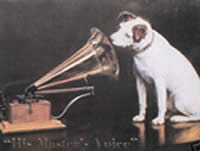Thomas Edison had been working on telephone equipment at the time he conceived the phonograph. Alexander Graham Bell announced his telephone in 1876, and many inventors set out to duplicate and improve it. Edison, drawing on his vast experience in telegraph equipment, in July 1877 conceived of the idea of using a sensitive electromagnetic device to inscribe telephone messages on a strip of wax-coated paper. Probably unknown to Edison was a similar concept described in April 1877 by Frenchman Charles Cros. The latter would later claim precedence with some justification.

Early graphophone
A sketch of one of Edison’s earliest phonographs. A sheet of thick tinfoil, wrapped around cylinder “C” is indented by a stylus attached to diaphragm “A.” This hand-cranked machine was of the type used to demonstrate the principle. Production models had provisions for keeping the speed constant and other improvements.
After some experimentation, he turned instead to a device that could record straight from the air instead of relying on a telephone connection. This line of inquiry resulted in the construction of the first functional phonograph in early December, 1877. He demonstrated it almost immediately in the New York office of Scientific American magazine, and in subsequent months the publicity the invention generated resulted in a new nickname for Edison: “The Wizard of Menlo Park” (referring to his Menlo Park, New Jersey laboratories).
Edison did little to commercialize the phonograph himself, and a limited number of licensees made unsuccessful attempts to sell the new device, including a German firm that introduced a talking doll.
Within a decade, however, Edison had a new competitor in the form of the Graphophone. Essentially an improved phonograph, the new recorder stimulated Edison to return to his invention, and the result in 1886 was the improved phonograph. Phonograph and Graphophone licensees attempted to lease or sell the devices to stenographers to replace hand-writing. They made little money until someone had the bright idea to make a coin-operated phonograph for public amusement. By supplying ready-made cylinders, they transformed the device into an entertainment technology. Following much legal wrangling over patents in the 1890s, Columbia Phonograph emerged as a major competitor to the Edison company, and survives today as part of CBS Records.

This painting of a dog listening to a Gramophone became Victor’s advertising trademark after about 1899
A third important company was founded by inventor Emile Berliner, and based on his own variation on the basic idea of recording sound mechanically as a wavering groove. His system, using a flat disk record instead of a cylinder, was available in Europe in 1889, and was introduced in the US in 1894 after the inventor’s move to Philadelphia. Berliner called his technology the Gramophone. By 1901, Berliner’s company changed its name to The Victor Talking Machine Company, while in the U.K., the Gramophone Company had been formed in 1897. Berliner, a native German, also formed the Deutsche Grammophon company with his brother in 1898.
Victor Talking Machine Company was already a major force in the music industry in 1906 when it introduced its first “Victrola,” a disc player with the horn inside the cabinet instead of outside it. This and subsequent generations of Victrolas became top-sellers, and “Victrola” became a generic term for the record player in the U.S.